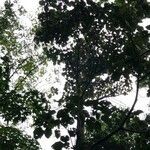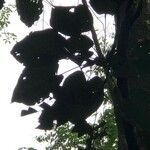A polygamous-dioecious, medium-sized to lofty, buttressed tree, up to 40 m, with a dense crown and ± drooping branches; trunk up to 1 m diam.; young branches ± densely rufescent-tomentose, old branches glabrous, with large leaf-scars. Bark reddish-brown or brownish-grey to dark brown, smooth or somewhat roughened by flaky decortication and horizontal fissures. Leaves large, ovate-cordate, entire, dark-green, glabrous, shining above, but dull and rusty-scurfy beneath especially on the veins, (10-)12-30(-40-60) by 8-20(-25-40) cm, 5-7-nerved from the base; petiole 7-30(-50) cm, much swollen at the base. ♂ Racemes 4-9-flowered, sometimes the bigger terminal flower (or rarely the 2 highest flowers) hermaphrodite, the others smaller and with stamens only, 6-24 cm long including the stout, 5-12 cm, long rusty-tomentose peduncle. Pedicels 2.5-4 cm, brown-pubescent, sustained by a subulate bract 1-3 cm. Calyx rusty-scurfy in bud, lobes reflexed in anthesis, glabrescent, ¾-1¼(-2) cm long. Petals ovate-oblong, somewhat fleshy, ciliate, patent, later on reflexed, bright pale green, 1.5-2.5 cm, each provided with an ovate or subrounded, densely appressed-hairy scale. Stamens inserted on a flat, villous disk, half as long as the petals. ♀ Flower mostly solitary, 6-9(-12) cm pedicelled, and with 5-8 anantherous staminodes, occasionally in few-flowered racemes (then the flowers seemingly ☿ but really ♀ as the 20-25 staminodes carry empty anthers). Calyx and petals as in male, but petals somewhat larger. Disk annular, small, fleshy, pubescent, surrounding the ovary at its base. Ovary ovoid, sessile, sericeous. Fruit somewhat asymmetrical, mostly oblong-ovoid ('pear-shaped'), 15-25(-30) by 7.5-12(-15) cm, variable in size, brownish, rather scurfy and rough by small lenticels, bluntly tipped at each end, pendent from a thick, brown, curved stalk, 8-15 cm long, 7-12 mm diam., containing about 20 irregularly shaped seeds which are closely packed; pericarp 6-10 mm thick, becoming soft and mushy in the ripe fruit. Seeds (3-)4-6 by 2-3(-4) cm, enclosed by a white, fleshy aril, greyish-white when fresh, blackish when weather-beaten, leathery.
More
A large tree reaching a height of 25-40 m and about 50-100 cm across the trunk. The crown of the tree can spread to 50 m across. It has buttresses. The branches normally droop over. The leaves are very large and smooth. They can vary between 10 to 60 cm long by 8 to 40 cm across. They can be entire or lobed, pointed at the tip and rounded or heart shaped at the base. Leaves in young trees have 3 lobes. Often leaves are in a spiral arrangement near the ends of branches. Flowers are separate sexes and often on different trees. The flowers are yellowish white and have a faint smell. They are about 4 cm wide. The fruit are large, up to 15 cm long, brown and contain several seeds embedded in yellowish edible pulp. The seeds are about 5 cm long. The fruit has a strong smell.
Primary and secondary rain-forests, in many regions chiefly in deforested localities, always in isolated specimens though locally common, wild or semi-cultivated, also along river-banks, in teak-forests, on both dryland and temporarily inundated places, on stony or clayey soil, chiefly below 300 m, but up to 1000. Fl. Jan.-Dec., fr. mostly at the beginning of the rainy season.The seeds are well fitted to dispersal by water and have excellent floating capacity; they are frequently found in the beach drift. Occasionally trees are found in the beach forest, but Pangium is certainly not a beach tree as has been sometimes wrongly assumed.Trees which produce mostly male flowers also may bear fruit as the terminal flower in many inflorescences is often bisexual.
More
A tropical plant. It is native to SE Asia. It is a plant of the hot humid tropics. They are widely distributed in primary forests and clearings at low and medium altitudes from southern Luzon to Palawan and southern Mindanao in the Philippines. It mostly grows below 300 m altitude but can be up to 1000 m. It is in the lowland and mid altitude rainforests often near creeks. It prefers slightly acidic soils. It can be in mangrove swamps.
Primary and secondary rain-forest; often in deforested areas, either wild or semi-cultivated; riverbanks; teak-forests; both dryland and temporarily inundated places; on stony or clayey soil; at elevations to 300 metres, occ to 1,000 metres.
Uses. Pangi is used for many purposes throughout its area of distribution. The tree starts fruiting when c. 15 years old. Leaves, seeds and most other parts of the tree contain a high percentage of gynocardin, a glucoside which readily yields prussic acid, which is fugitive and is eliminated from the seeds before using them in various ways (washing, soaking, roasting, subterranean storage), so that they can be eaten when boiled or roasted. There are various methods to prepare them, cf. Heyne ( Heyne Nutt. Pl. 1927 ) and Burkill ( Burk. Dict. 1935 ); the product is known in Indonesia as kluwak, kelewik, trasi putjung, betong, dage, katjap pangi or jaruk. Fresh leaves or seeds or their oil are used as an antiseptic, des-infectant or antiparasitic, to preserve meat, to prepare dart poison or to kill fish; the bark is also used as piscicide. Raw seeds are especially poisonous to poultry. The oil extracted from the seeds is a substitute for coconut oil in cooking; it can also be used as an illuminant or for making soap. The sapwood and heart-wood is (light-)yellow, with a disagreeable odour, rather hard, but little durable, used for construction of houses by the people of the Div. East Coast of Sumatra. The shells are used as rattles on dancing masks in New Guinea (Wide Bay).
More
The old leaves are eaten after shredding and being cooked. The fleshy portion around the seeds is eaten raw or cooked. The seeds are eaten after steeping and roasting in an extensive process to remove poison. Sometimes seeds are buried and fermented for about 40 days. The seeds yield a cooking oil. CAUTION All parts of the plant can contain large amounts of poison (Prussic acid). This must be thoroughly removed by processing. Mature fruit are less poisonous than young fruit.



